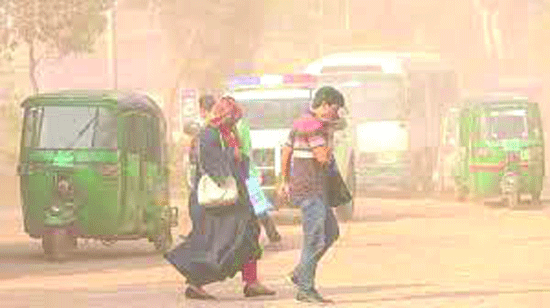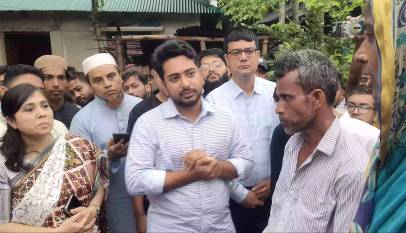Dhaka’s air full of toxic black smoke
Unfit vehicles plying on City’s roads randomly
Golam Mostafa Jibon:Black smoke emitting from unfit vehicles especially from old and date expired buses has become cause of serious health hazard to the city dwellers due to lack of proper monitoring of the authorities concerned.
Experts said, the air of the capital have now become full of poison due to emission of black smoke from the unfit vehicles. It has now become difficult to move around in the dusty city even after wearing masks. But, there is no headache of anyone involved in the operating cycle.
Sources said, most of the public transports do not have the fitness though they have valid driving documents. These transports are emitting black smoke as well as creating uncomfortable condition due to the loud noise of the engine. The city’s roads are getting polluted as there is no smoke filter system in the silencers of the vehicles.
Occasional mobile court raids on the roads and highways have led to the seizure of some unfit vehicles, but it has not been possible to eradicate these at all.
Sometimes some vehicles’ drivers and workers were fined a little amount of money, but the effort is not coming to help to reduce air pollution in the city.
In contrary, air pollution in the capital is constantly increasing. As a result, people are being affected with various types of diseases including cancer, heart disease, asthma,
shortness of breath and reduced lung function in the human body. They are being forced to spend huge amount of money each year against the treatment of those diseases.
In this circumstance, the transport owners are blaming adulterated fuel for this situation. According to the Air Quality Management Project of the Department of Environment, on an average of about 3 lakh mechanical vehicles ply in Dhaka city every day. City dwellers have been suffering from high levels of air pollution as most of the main roads, which are used for plying of such vehicles, are located adjacent to residential areas. Of the sufferers, the most vulnerable groups include pedestrians, peddlers, shopkeepers, traffic police and drivers.
Traffic Department of DMP sources said, accidents often occur on different roads due to the difficulty of controlling unfit vehicles, causing loss of life and property to the public. A large portion of other vehicles, including privately owned vehicles, play a major role in air pollution. These low quality vehicles are emitting harmful particles such as carbon monoxide and carbon dioxide. The unfit motor vehicles make the roads and highways’ environment dusty, which has a negative impact on human health.
Officials of the Air Quality Management Project said that the vehicles operating in the capital mainly use three types of fuels namely diesel, petrol and CNG. Air pollution is caused due to defects in engine design, lack of regular maintenance, non-use of quality fuels, lubricants and carrying extra passengers or goods.
Due to combusting of below standard fuel oils, fine particulate matter 2.5 PM are being emitted into the air.
Officials added that the vehicle would have to travel at a speed of at least 6 kilometers per hour to reduce the emission of fine particulate matter PM 2.5. But, it is almost impossible to drive at such a high speed in this congested city.
The Contaminants, which are found from diesel emissions, are fine particulate matter, nitrogen oxides, hydrocarbons, organic toxins, poly nuclear aromatics. Besides, the pollutants emitted from petrol, octane and CNG-powered vehicles included idol carbon monoxide, idol hydrocarbons, which increase the risk of diseases such as cancer, heart disease, asthma, shortness of breath and reduced lung function in the human body.
Not only that, the air is also being seriously polluted by the smoke emitted from the brick kilns in the vicinity of the capital. It is increasing lung cancer, respiratory problems, tuberculosis, pneumonia and other diseases.
Despite repeated stern messages from the high court about the pollution in Dhaka, there is no effective measure.
According to Air Visual, an area is considered healthy, if it’s AQI score is below 50. A score of 51 to 100 is tolerable, from 101 to 150 is unhealthy for a special class of people, from 151 to 200 is unhealthy, from 201 to 300 is very unhealthy and from 301 to 500 is dangerous. Environmental experts said, unplanned urbanization and industrialization are polluting the air. There is a lot of construction going on in the capital, which is creating dust.
Uncontrolled construction works, construction of factories at residential areas, setting up brick kilns at urban area, non-compliance with the rules are also the main among many other reasons behind the continuous pollution.
The amount of sulfur dioxide in the air mixed with water causes eye irritation. This can lead to many health risks ranging from pneumonia. Apart from that, among the dust particles in the air, the elements below PM-2.5 are the most harmful. Due to lack of law enforcement, pollution in Dhaka is now very visible.
As there are no gas filling stations everywhere, long-distance bus-trucks use liquid fuel. These buses and trucks are entering the capital regularly. Thousands of trucks are entering Dhaka at night with construction materials and agricultural products. Many cars are now returning to use liquid fuel instead of gas for want of adequate CNG filing stations.
According to the Bangladesh Road Transport Authority (BRTA), there are about 5 lakh date expired vehicles in the country. A large part of it runs in Dhaka city. Despite regular campaigns, the number of expired vehicles is increasing at a rate of 20-30 percent every year. These are emitting black toxic smoke in the air.
Road Transport and Bridges Minister Obaidul Quader recently said, the number of unfit vehicles in the country is 4,81,029. But sorry, there is no visible steps to stop those vehicles.
Rare Israeli airstrike in Beirut kills Hezbollah commander and more than a dozen others
International Desk: Israel launched a rare airstrike that killed a senior Hezbollah milita…








